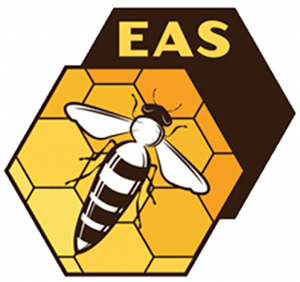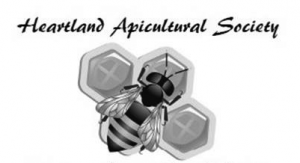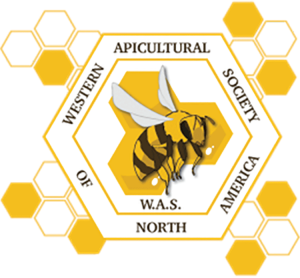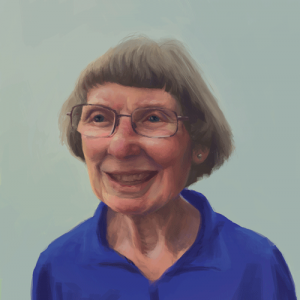By: Ann Harman
No matter where you live in the U.S. you had a big regional bee conference in your area this Summer. You either went somewhere else for a vacation or stayed home. Those of you in the East could have attended the Eastern Apicultural Society (EAS), the oldest one, started in 1955. The middle of the country has the Heartland Apicultural Society (HAS) while out West there is the Western Apicultural Society (WAS).
Membership in these is not restricted so that you will find beekeepers being members of two or even all three. Both HAS and WAS were started with the encouragement of EAS so that beneficial beekeeping information could be given to beekeepers without their incurring very long distance travel. As with EAS, both HAS and WAS include the Canadian provinces north of their region.
The conference programs of all three regionals are similar. Their conference meeting place changes each year, keeping within the territory designated. In general there will be presentations that are suitable for all levels of expertise, from beginners on up to experienced beekeepers. The speakers will be researchers, local or regional beekeepers, apiary inspectors, and other specialists in the world of beekeeping. How-to-do-it workshops provide all beekeepers a chance to learn a skill or craft. Local beekeepers provide hives for open-hive demonstrations. Sometimes tours are offered, not only beekeeper-oriented but also for local places of interest. Banquets, barbecues and other social events bring beekeepers together where they can share their successes and catastrophes. The vendors’ displays feature the large commercial bee equipment suppliers, smaller local ones as well as local crafters. A business meeting is usually held for officer elections and to choose future meeting sites.
Now let’s take a more detailed look at what you missed. We’ll start with the oldest one, EAS. Its region covers all the states east of the Mississippi River and includes the Canadian Provinces of Ontario, Quebec and the Canadian Maritimes. However people from all over the U.S and sometimes from around the world attend. This year the host state was Delaware for the third time there. The Conference Center of the University of Delaware was the site of all the activities. In addition, the university’s apiary was used for open-hive work. At the university, Dr. Deb Delaney, Professor of Entomology and Applied Ecology, conducts honey bee research and helped coordinate the EAS event held there from July 31 through August 4.
 The EAS Short Course is divided into levels, Beginner, Intermediate and Advanced but those who attend can go to lectures at any level. For example, the Beginner level included Bee Biology and hive inspections in the apiary. In the Intermediate level the topic of nucs and their uses was presented. In the Advanced, beekeepers could learn microscopy and dissection of bees. The problems of Varroa mites were included in all levels. Open-hive work in the apiary was an important part of the Beginner and Intermediate levels.
The EAS Short Course is divided into levels, Beginner, Intermediate and Advanced but those who attend can go to lectures at any level. For example, the Beginner level included Bee Biology and hive inspections in the apiary. In the Intermediate level the topic of nucs and their uses was presented. In the Advanced, beekeepers could learn microscopy and dissection of bees. The problems of Varroa mites were included in all levels. Open-hive work in the apiary was an important part of the Beginner and Intermediate levels.
The conference itself, beginning on Wednesday and continued Thursday and Friday, featured two keynote speakers to start the day. After these two presentations the rest of the morning was split into five separate sections where you could take your choice of topics and speakers. Apiary time was scheduled in the afternoon as well as several presentations. Evening programs, after dinner, were for entertainment. Since Delaware has several famous botanical gardens, afternoon tours of these were scheduled. Programs for children were given on two days. You could enjoy a special evening visit to Delaware’s only meadery.
EAS gives several awards: the Hambleton Award for an outstanding bee scientist, the Student Award for an exceptional graduate student, The Roger A. Morse Award for Teaching/Extension/Regulatory activity, the Divelbiss Award for public outreach. In addition a fund was created for a stipend to a honey bee researcher. The EAS Master Beekeeper program, begun in 1981, is a series of four exams: written, lab, field and oral. These exams are given early in the week. The EAS Honey Show has been held for many years at the conference and brings in entries representing the many honeys of the East Coast.
Now let’s see what you missed this year. Presentations by Jennifer Berry, Michael Palmer, Tom Seeley, Marla Spivak, Jay Evans (USDA), Jim Tew, Tammy Horn Porter, Bart Smith, Maryann Frazer, Kim Flottum, Vince Aloyo, and a number of others. Entertainment by Cliff Sunflower with his Dancing With The Bees, Bee Jeopardy with Howland Blackiston, a honey tasting workshop with Marina Marchese, Sarah Red-Laird and all the kids, including a session with deaf children, all topped off with Jim Tew as the banquet speaker. What a week!
 Let’s cross the Mississippi River into the territory of the Heartland Apicultural Society (HAS). Although this region could include those states west of the Mississippi River to the border of Colorado and also the Canadian Province of Manitoba, conferences have usually been in Indiana, Illinois, Missouri and Michigan, as well as a few in Kentucky and Tennessee. This year the 15th annual conference was held July 13 through 15 at the University of Southern Indiana.
Let’s cross the Mississippi River into the territory of the Heartland Apicultural Society (HAS). Although this region could include those states west of the Mississippi River to the border of Colorado and also the Canadian Province of Manitoba, conferences have usually been in Indiana, Illinois, Missouri and Michigan, as well as a few in Kentucky and Tennessee. This year the 15th annual conference was held July 13 through 15 at the University of Southern Indiana.
Discovering the program and activities on the website was difficult.
Since the conference actually started early on Thursday morning, many beekeepers came on Wednesday. HAS planned a movie night for those who arrived on Wednesday. The program began each day with a speaker in the main meeting hall for all attendees. After a short break the beekeepers had quite a few choices of programs. The beginning beekeepers had their special program each day with time in the apiary for open-hive work.
The concurrent breakout sessions each day featured two apiary sessions – one of those especially for beginners. Four separate tracks were suitable for all beekeepers. A special Lab session was offered only in the morning. An Advanced track and a Queen Rearing session completed the day’s choices. Some of the sessions were repeated during the three days. The Thursday Lab session topic was nosema and the Friday one was anatomy. Queen rearing sessions also had apiary times. The topics in the breakout sessions covered just about everything to do with bees and beekeeping, including apitherapy, planting for bees and top bar hives.
HAS also has a honey show similar to that of EAS. In addition this year a special Art Exhibit was held for everyone’s enjoyment. The art items were brought by those attending the conference. Paintings, drawings, photographs, wax art, encaustic painting, and even antique items, all with bee and beekeeping themes, were accepted for display. Craft items were not included.
On Thursday night, after dinner, an ice cream social gave everyone a chance to talk – about bees of course. Friday night everyone enjoyed “a good old BBQ.” The conference ended Friday afternoon at 4:00.
Lets see what you missed here. Presentations by Ernesto Guzman, Jeff Harris, Zach Huang, Tom Webster, Greg Hunt, Jim Tew, John Skinner, Jerry Hayes and Tammy Horn Porter. And you also missed the Art Show, the ice cream and the BBQ
 It’s time to move to the Western Apicultural Society’s annual conference. This conference marked their 40th year. The territory WAS covers are the states of Arizona, California, Colorado, Hawaii, Idaho, Montana, New Mexico, Oregon, Utah, Washington and Wyoming, as well as the provinces of Alberta, British Columbia, Saskatchewan and the Yukon. That is a large area with quite a range of climates!
It’s time to move to the Western Apicultural Society’s annual conference. This conference marked their 40th year. The territory WAS covers are the states of Arizona, California, Colorado, Hawaii, Idaho, Montana, New Mexico, Oregon, Utah, Washington and Wyoming, as well as the provinces of Alberta, British Columbia, Saskatchewan and the Yukon. That is a large area with quite a range of climates!
The chosen site this year was the University of California at Davis where much bee research is conducted. Dates were September 5-8. The conference met for the main lectures at the ARC ballroom with the vendors in the adjoining part. Events were also held at the Bee Biology Facility and the Bee Haven Garden.
Tuesday evening, the 5th, there was the Bee Buzz Social in the evening. The conference was to begin Wednesday morning with a presentation by Serge Labesque on the Seasonal Honey Bee Colony Population Cycle, but a family issue caused Serge to miss the program, so Amina Harris, Director of the UC Davis Honey and Pollination Center at the Robert Mondavi Institute stepped in. Her topic was Moderated Honey Tasting.
On Wednesday afternoon the beekeepers were offered a choice: a series of tours or a three-part Short Course by Dr. Larry Connor on Keeping Your Bees Alive and Growing, for an extra charge. The four tours were organized with transportation so that the attendees would visit all four. The tours were: (1) the Mann Lake warehouse and showroom plus their sugar syrup blending facility, (2) the Z Specialty Food Company that sells the Moon Shine Honey Company’s honey and hive products, (3) the UC Davis native bee habitat restoration project and (4) the Häagen Dazs Bee Garden.
Mini-sessions were given at the Bee Biology Facility and the garden on various topics such as preparing bee samples for molecular studies, selecting plants for bees, and types of beehives that contained colonies.
Thursday morning and all of Friday presentations were given in the ARC Ballroom. Topics included Varroa, African honey bees (they are in California and other WAS states), native bees, top bar hive management and queens. Rod Scarlet, the Executive Director of the Canadian Honey Council, presented Topics of Interest from Canada.
The banquet was held on Friday evening marking the close of the conference. Two awards were given: one for Outstanding Service to Beekeeping (including U.S. and Canada) and a local award, the Thurber Award for Inventiveness.
Let’s see what you missed at UC Davis. Elina Niño, Randy Oliver, Eric Mussen, Kim Flottum, Larry Connor, Robbin Thorp (native bees and bumble bees), Rod Scarlet of Canada, honey tasting, the tours of Wednesday and the demonstrations at the Bee Biology Facility and Bee Haven Garden.
Now go and attend your local club meetings. Maybe someone there attended a regional conference and can bring you up to date. Now is the time to start planning to attend one of these conferences in 2018!










